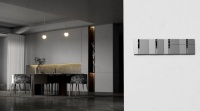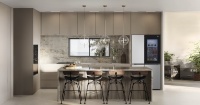“城南计划”前门东区2014展览10月底启幕
开幕:2014年10月28日
展期:2014年10月29日-11月28日
地点:北京市平安大街玉河1号 天安时间当代艺术中心
参展方:
北京市建筑设计研究院艺术(艺术装修效果图)中心(朱小地)
都市实践(王辉、刘晓都、孟岩)
K/R(John Keenen、Terence Riley)
家琨建筑设计事务所(刘家琨)
MAD(马岩松、党群、早野洋介)
MVRDV(Winy Maas、Jacob van Rijs、Nathalie de Vries)
如恩设计研究室(郭锡恩、胡如珊)
沈伟舞蹈艺术舞团(沈伟)
隈研吾建筑都市设计事务所(隈研吾)
有方(史建、朱涛、赵磊)
艺术总监:翁菱
主办:北京天街集团、北京市建筑设计研究院、天安时间当代艺术中心
前门也称正阳门,位居明清北京城内城九门之首。前门外,则成为老北京建筑文化、商贾文化、梨园文化、会馆文化、民俗文化叠加的汇集之地,历经了600年的风雨沧桑,寄托了无数人的情愫与梦想。近年来,以前门大街、鲜鱼口街为代表的前门西区进行了大量修缮和更新,看到了旧城重生的决心和力度。而向东与之相邻的前门东区却成为都市核心的衰落区域,其残旧的街巷院落与周边现代(现代装修效果图)化的城区景观形成了剧烈反差。
路往何处去?多年来,这一问题始终牵动着关注北京旧城变迁的各界人士。如何以最小的代价换取区域的复兴?如何最大限度地保护旧城的民生和文脉?如何平衡经济发展与环境需求?面对这一系列问题,可供借鉴的是在外迁开发模式外,南锣鼓巷、798和大栅栏已呈现出来的新方向,而东城与崇文合并,大东城行政区划带来的经济和资源更强有力的整合,使得探讨这一区域全新的旧城改造计划成为可能。
秉持旧城有机更新与复兴的理想,北京天街集团、北京市建筑设计研究院、天安时间当代艺术中心联合向国内外多家知名建筑规划机构、各相关领域专家学者和意见领袖发出邀请,组成阵容强大、涵盖广泛的跨专业、跨学科城市问题联盟,由著名综合艺术策划人翁菱出任艺术总监,力求通过对全球化大背景下城市问题演变趋势与应对城市问题新方法、新途径的探索,让北京这座城市的历史与未来,光荣与期待,在此相聚。
参与此次联盟的有专注城市规划、建筑设计和景观设计,成果涵盖建筑、规划、出版物及装置物的建筑事务所MVRDV;关注当代建筑设计趋势及全球问题,以深切洞悉博物馆(博物馆装修效果图)历史著称的建筑师、建筑策展人Terence Riley;建筑作品散发日式(日式装修效果图)和风与东方禅意,以自然景观的融合为特色,“负建筑”、“隈研吾流”创始者隈研吾;注重最大可能地满足人的需求,不追求形式上的新奇怪异,而是创造未来的MAD建筑事务所创始人马岩松;将个性思想纳入理性设计中,追求激发观众在空间中动态的心理体验的北京建筑设计院院长朱小地;从“艺术家工作室”开始出手,擅长以小型文化空间完成对环境的把握和并获得解决问题的创造力的建筑师刘家琨;致力于从城市视角和城市体验中解读建筑内涵,以研究城市问题为基础致力于建筑学领域探索的机构都市实践;立足于中国上海,以全球化的观念结合多元、重叠的设计理念,创造多元化建筑的如恩设计研究室;以极具开创性的跨文化和跨媒介创作发展出“自然身体发展”独特技术体系的编舞家、视觉艺术家和导演沈伟;以及一直致力于推动中国建筑文化发展,及其与世界建筑文化交流的有方空间文化发展机构。
此次由专家牵头的跨界活动将致力于以学术层面的研究讨论,全新探寻城市的功能和空间演进、旧城改造与民生保障、历史文脉的保护与传承等几大综合性问题。基于总体规划的展览和论坛为本次计划的核心,所有参与者在统一任务书的指导下,用模型、视频、访谈、空间作品、舞蹈等多种形式,集人文、艺术、科学的思考为一体,对各方观点进行丰富、鲜明地对话与呈现。主办方高度赞赏国内外跨界知识精英和专家学者对此次计划的全情参与,并深信他们以各自专业精神呈现的思考与方案,是真正参与到解决现实问题中来的宝贵实践,也是为全社会献上的精彩智慧财富。我们亦诚邀社会各界人士的参与,集思广益,共同探索旧城改造与复兴的理想之路。
CHENG NAN PROJECT – QIANMEN EAST AREA 2014
Opening: 28th-10-2014
Duration: 29th-10-2014 to 28th-11
Location: No.1 Jade River, Ping An Ave., Dongcheng Dist., Beijing, China
Participates:
BIAD ART CENTER(Zhu Xiaodi)
JIAKUN ARCHITECTS(Liu Jiakun)
KKAA(Kengo Kuma)
K/R(John Keenen、Terence Riley)
MAD(Ma Yansong、Dang Qun、Yosuke Hayano)
MVRDV(Winy Maas、Jacob van Rijs、Nathalie de Vries)
POSITION(Shi Jian、Zhu Tao、Zhaolei)
SHEN WEI DANCE ARTS(Shen Wei)
URBANUS(Wang Hui、Liu Xiaodu、Meng Yan)
Artistic Director: Weng Ling
Host: Tian Jie Group, Beijing Institute of Architectural Design, Beijing Center for the Arts
The old town of Beijing composes of the inner and outer city, the outer city is known as Nan Cheng. Established during the Ming dynasty, this area was once known as “Zheng Dong” square, now Qianmen East Area or Xian Yu Kou. The area was the financial centre of the city in the Qing Dynasty, responsible for river logistics and counter flood measures. It includes “Chang Xiang” (1-5 lanes) and “Cao Chang” (1-10 lanes) hutongs, mostly running from north to south and uncharacteristically curved and winding compared to conventional hutongs. The structure of this area reflects how it came to be, developing around the river system and rich with history and culture.
Recently the revival of the Dashilar district received widespread attention and entered the Venice Biennale. However, the Xian Yu Kou area directly opposing the Dashilar is gradually degenerating, becoming irrelevant and decadent. The old and decaying streets and infrastructure creates a stark contrast to its rapidly developing neighbours.
The question of future development has been an ongoing question for years: how to revive an old area with minimal damage and preserve the architecture, the people residing within, and heritage? How to balance between economic development and environmental protection? We can look upon past projects such as Nan Luo Gu Xiang, 798 and Dashilar to point us in the right direction. As Dongcheng and Chongwen districts merge, the bigger Dongcheng district provides more land resources and financial strength, making the discussion of sustainable future development a relevant and important one.
With a dream of organic and sustainable urban development and city refurbishment, Beijing Tianjie Group, Beijing Center for the Arts (BCA) and Beijing Institute of Architectural Design (BIAD) unite forces and convene domestic and international specialists and experts in various fields to create an alliance panel from a wide range of professions. Led by renowned contemporary art curator and senior event organiser Ms. Weng Ling, seeking to explore new solutions to resolve issues of urban development in the age of rapid change and globalisation. Let Beijing’s past with the future, glory and anticipation all converge here.
Led by our panel of experts, this project aims to discuss contemporary issues from an academic perspective: a city’s change in space and functionality, refurbishment and inhabitant’s livelihood preservation, history and heritage site protection. The project will be conveyed through a large exhibition and discussion forums, using models, videos, interviews, installation projects and dance performances, bringing in culture, art, science, architecture and social considerations into one conversation. Believing in the contribution and different perspectives that each participant can make, this project embarks on a journey of exploration and realisation of a shared dream to contribute and improve our society and infrastructure, to revive past prosperity in a sustainable manner.
1
BIAD ART CENTER
北京市建筑设计研究院艺术中心
由建筑师、空间艺术家朱小地主持创立的“北京市建筑设计研究院艺术中心”长期关注城市规划与建设过程中政府角色的转变与公众参与的可能性,因而将公共空间作为城市研究的重要对象,致力于通过公共空间的营造,在公共与个人之间建立起新的利益平衡,形成动态规划理论。在北京旧城保护与更新的领域,提出开发地下公共空间的设想,解决历史街区市政资源严重不足的现状,从而构建新型的、有机更新的模式。
Founded by architect and artist Zhu Xiaodi, the BIAD Art Center follows the change of the government's role in urban planning and development and the possibility of public participation. Mr. Zhu indicates that communal space is the key to balancing public and private welfare. To protect and update the old city of Beijing, he proposes to develop underground communal space, which provide an imperative urban infrastructure, and build a new organic updated model according to dynamic urban planning.
“民有化”——北京旧城文化复兴的起点
北京旧城保护应该从历史街区实体保护转向文化整体保护,不仅包括对街巷、院落和建筑的保护,更重要的是让老北京人有更多可能性,继续生存在原环境、并保持与外界的有序流动。这是维系和发展文化的必要条件。
现实情况是原住民,无论其居住房产属于直管公房、单位公房还是私有住房,都被现行拆迁政策引导到必须离开原住地的方向,以至于没有人关心住房的现状和未来。
因此,北京旧城亟待实现住房“民有化”,让原住民获得现住房,唤起其对自宅和环境的热爱,进而激发其参与城市更新的积极性,摆脱政府与拆迁户对立的局面。
“民有化”概念的提出,旨在明确原住民与房屋的产权关系,政府从过去的拆迁方转变为城市公共资源的提供者。这不仅实现了政府角色的正向转变,而且使原住民成为了决定自己未来的主人,在旧城更新过程中获益,并自主选择在城市中的生活方式。
“Privatization”/”Civic owned” – The start of cultural renaissance of Beijing old city
The main goal of historic preservation of Beijing old city should be shifted from historic sites restoration to overall culture inheritance. The preservation should not be only about reorganizing the urban fabrics and repairing traditional yards accordingly, but also providing more opportunities for local citizens. Encouraging the local citizens to stay in their original dwelling place and keep interacted with other new districts of the city is a necessary premise of cultural inheritance.
According to the related policies of refurbishment and demolition, no matter the property right of those historic yards belongs to government, companies or citizens, the residents there are encouraged to move out. Thus, no one cares about the conditions of these buildings, which leads local residents’ living condition into an embarrassing status.
Therefore, properties in Beijing old city need to be transformed into a new type – ‘Civic Owned’, urgently. This proposal allows local residents to obtain the property right of their own houses, arousing their enthusiasm to improve the living conditions and neighborhood environment. Furthermore, it also encourages people to participate in the urban refurbishment spontaneously, avoiding unnecessary conflicts between citizens and the government.
This proposal of ‘Civic Owned’ aims to guarantee that local residents have the ownership of their houses. The government turns into the provider of urban public resource instead of demolishing department. ‘Civic Owned’ helps government to play a positive role in the development of Beijing old city. In addition, local residents could become the decision makers of their own life. In the future, they will constantly obtain benefits from the development of old city and have opportunities to satisfy their own living preference.
2
JIAKUN ARCHITECTS
家琨建筑设计事务所
家琨建筑设计事务所成立于1999年。事务所组织并参与多项国际建筑合作、展览和交流。项目业主分布于中国各地及欧洲,工作范围涵盖项目策划、城市设计、建筑设计、景观设计、室内设计、产品设计及当代艺术创作。
理念:
1. 与自然共生
2. 尊重历史、关注现实
3. 向民间智慧学习
4. 此时此地、因地制宜的现实精神
5. 致力于东方意蕴的当代建筑诠释
Jiakun Architects was founded in 1999. As a multidisciplinary office, Jiakun Architects’ field of work includes architectural design, large scale planning, urban design, landscape design, interior design, product design and contemporary art. The office has organized and participated in multiple international collaborations and exhibitions. Our clients are widely distributed all over domestic and overseas markets. Our design aims to deal with contemporary architectural issues with a sense of realism - an approach inspired by folk wisdom. With a faith in the compatibility of traditions and realties, we have been devoted ourselves to translate oriental cultural essence into contemporary architectural language.
前门鲜鱼口地块城市演进
壮士断臂:现实地面对旧城保护不可回避的资金短缺问题,对保护区周边做出适度牺牲。
因势利导:沿周边进行商业开发,利用政策绑定开发收益,作为区域保护的资金来源。
以攻为守:周边新楼形成边界,抵制外围开发对保护区的进一步蚕食。
亡羊补牢:保护区内不拆不迁,弱化矛盾;全面保护,渐进修缮;杜绝仿古,保持本真。
起死回生:点状更新,激发活力,扶持传统业态,引入新小产业,重现旧城繁荣。
An Urban Quintet of Xian Yu Kou
1st Movement: calculated sacrifice
Financial difficulties will inevitably become a key issue in the preservation of old city, strategic and calculated sacrifices must be made initially in the peripheral area。
2nd Movement: Leverage
Backed by supporting regulations and policies, funds generated from commercial activities at the peripheral area can be used to maintain, renew and develop the core protected zones
3rd Movement: Fencing
Fortify the core protected zone by using the peripheral buildings as a fence to keep out further encroachment from commercial activities.
4th Movement: Remedy
No further demolition or relocation to be done in the core protected area, repair and maintain existing buildings to keep its authenticity, heritage and historic value.
5th Movement: Revival
Revitalize the community by attracting attention to the area, support small businesses and revive the prosperity the area once possessed.
3
KKAA
隈研吾建筑都市设计事务所(KKAA)是一家落地东京、巴黎、北京,在世界各国有约50个项目推进的国际型建筑设计事务所。通过对当地自然材料、施工技法的运用,使建筑与当地文化、自然环境相协调,KKAA将唤醒在20世纪的工业化时代中人们失去的【人-建筑-场所】联系中充满活力的羁绊。
Kengo Kuma and Associates is an international urban/architectural design firm with its branch offices in Tokyo, Paris and Beijing, currently proceeding with approx. 50 projects in different regions of the world. Through application of local natural materials and craftworks, and harmony with cultural/natural environment, we aim to revitalize the connection between the [people- buildings-place] that has been left behind during the era of industrialization in the 20thcentury.
对于北京城中留有最深历史印记的前门东区,我们提出类似于中医里不破坏现有肌理,仅对组织的深层伤害提供治疗的城市再生方案。与基于体量及等级体系的西方【外科手术】般的城市设计方法不同,我们注重了城市中的【空】(=空地),通过使此【空】中浮游的【小粒子】如云般漂浮,在不破坏现有城市的同时给城市创造更灵动、惬意的活力。
在本次展览中,我们将展示对前门东区的设计案例研究,兼进一步展示此设计理念作为新时代的城市设计方法对世界其他城市可应用的有效性。
For this Qianmen East District, which holds one of the strongest historical contexts in old Beijing, we propose an approach of urban design similar to the idea of Chinese medicine. It provides cure into deep layers of the organs, yet not damaging the existing tissues. Unlike the “plastic surgery” of western medicine or urban design based on solid volumes and hierarchy systems, we have focused on the “空/kong”(=void) in the urban space, and formed clouds of “small particles” floating inside the “空/kong”, creating random and flexible activities without harming the existing city. In this exhibition, we are showing a case study for Qianmen East District, and exhibiting further that the effectiveness of such new concept can be applied to other cities in the world.
4
K/R
基楠莱利事务所(K/R)是一个知识力量雄厚且在建筑与设计实践中富有创造力的工作室。由约翰·基楠和泰伦斯·莱利领导的K/R非常善于结合环境,建筑,室内以及空间体验来满足客户及用户的方案设计需求。
在美国东海岸南北重镇纽约和迈阿密都设有工作室的K/R在过去的30年中,在建筑,城市规划,室内设计,博物馆规划,展览设计,可持续发展以及教育领域都作出了杰出的贡献。
同时,K/R在大型的文化类景观和城市规划项目上独树一帜,并在世界各地包括美国、中国、巴西、西班牙(西班牙装修效果图)、意大利以及法国等国家都有丰富的项目经验。
K/R (Keenen/Riley) is a knowledge- and creativity-based practice with a focus and dedication to architecture and design. Led by John Keenen and Terence Riley, K/R engages its clients in strategic conceptualization that leads to highly distinctive environments, buildings, interiors, and experiences.
With offices in New York and Miami, K/R’s collaborative effort has made distinctive contributions in architecture, master planning, urban design, interior design, museum planning, exhibition design, sustainability, and education.
K/R has particularly distinguished itself in developing strategies for large-scale cultural projects for both urban and landscape sites. Currently, K/R is active in the US, China, Brazil, Spain, Italy and France.
K/R 北京前门鲜鱼口项目提案是一个线性的城中城,目的在于两个层次,其一,强化并刺激城市历史的南北轴线;其二,通过聚集整合相邻社区的当前功能和需求来重新界定胡同边界,并提倡通过以最小化的侵介,最大化恢复胡同肌理与文化本身。
空间和体验的多元化通过水域、绿地、公园、道路、政府用地及公共空间贯穿着老北京的南北轴。长度约为1.5公里的鲜鱼口基地将贯穿于周线中并串联成一条紧凑连贯且适宜步行的城市长廊。这条城市长廊以构筑景观的形式穿过基地,界于前门东侧路与鲜鱼口胡同街区,拟营造出承北启南的城市公共空间。将现代城市功能和社会服务设施融入景观,是把胡同生活过渡为当代城市生活的一种解读。此外,恢复历史水路和步道则为了强化胡同和线型城市长廊的有机关系。
城市住宅、公共空间与服务设施的引入是以最小化改变现有建筑形态为宗旨,保留鲜鱼口地区生活文化现状。通过文化项目和相关联、可延展的景观将胡同与现代都市化北京合为一体。本提案接受并呼吁保存胡同完整性,鼓励未来更新,从而使胡同本身继续功能于邻里。
K/R’s Beijing Qianmen Xian Yu Kou project is a linear city-within-a-city that functions on two levels: first, the proposal strengthens and invigorates the city's historic north-south axis; second, by aggregating the adjacent neighborhood's contemporary functional and social requirements the edge of the existing historic Xian Yu Kou hutong, the proposal allows for minimal intrusion and maximal restoration of the hutong itself.
The diversity of spaces and experiences that run approximately 1.5 kilometers through historic Beijing - lakes, green spaces, public spaces, parks, roadways, and governmental terrain – suggest a continuous, walkable urban promenade along the major north-south axis that also threads through Xian Yu Kou. This urban promenade takes the form of a tectonic landscape that passes through and along the site, bordering the western edge of the hutong along Qianmen Dong Road, thereby connecting the neighborhood to a larger urban chain of public space. Incorporated into this landscape is a series of contemporary functional and social services and amenities that transform the adjacent hutong into a model of contemporary urban life. In addition, restoration of historic waterways and walkways strengthens the urban relationship between the hutong and the linear urban promenade.
The introduction of additional housing, public park space, and social services are seen as a way to preserve the life and existence of Xian Yu Kou with minimal architectural intervention to the neighborhood itself. As part of a larger urban vector, it literally unites the hutong to Greater Beijing through a host of cultural programming and a linked and expandable landscape. This strategy accepts the hutong as is and calls for keeping the it intact, encouraging future renovation and restoration, thus allowing it to continue to function as a neighborhood, much the same way that the Xian Yu Kou neighborhood thrives to the east of Cao Chang San Tiao Road.
5
MVRDV
MVRDV事务所由Winy Maas, Jacob van Rijs和Nathalie de Vries于1993年在荷兰鹿特丹创立,其设计和研究旨在为全球的当代城市规划和建筑设计提供解决方案。已建成的项目包括2000年汉诺威世博会荷兰馆和鹿特丹的市场大厅。MVRDV的作品遍布全球,并多次获得国际奖项。MVRDV同时与荷兰代尔夫特理工大学开展合作,开设“The Why Factory”智库与研究机构探讨未来城市规划与建筑。
MVRDV was set up in Rotterdam (the Netherlands) in 1993 by Winy Maas, Jacob van Rijs and Nathalie de Vries. MVRDV engages globally in providing solutions to contemporary architectural and urban issues. Realized projects include the Dutch Pavilion for the World EXPO 2000 in Hannover and the Market Hall in Rotterdam. The work of MVRDV is exhibited and published worldwide and receives international awards. Together with Delft University of Technology MVRDV runs The Why Factory, an independent think tank and research institute providing argument for architecture and urbanism by envisioning the city of the future.
胡同4.0版
北京鲜鱼口胡同升级再生
胡同组成了具有紧密社会联系的社区,并容纳着具有强烈差异的个性。自人类的第二个千禧年开始,在人口和经济压力的驱动下,胡同正在发生迅速的变化。
坐落在北京中心地带的鲜鱼口胡同也站在了这样的一个交叉口。未来它将变成什么样子?是又一片高楼林立的商务区吗?还是重返曾经的胡同生活?在商业化和博物馆化之外,有没有其他的再生途径呢?
通过增加密度和通达度,我们试图放大鲜鱼口这一传统胡同群落的价值:非正式、多样化、新奇......旧屋、古墙和现存的重要元素都将得到保留,并作为开发和重新解读这一区域的基础。每座四合院都将由不同的建筑师进行设计更新,由此形成一系列的四合院再生作品。从高端宅院到经济适用房,从老年人到年轻人,这种集体参与设计的方式将从更多元的角度解读和使用北京四合院。
在天安时间当代艺术中心的庭院内,数个以1:15比例呈现的胡同模型将悬浮在2.1米的半空中,营造由上至下的感官体验,讲述未来胡同和四合院里的美好新生活。
The Hutong 4.0
The Vision for the Xianyukou Hutong in Beijing
Hutongs form intense, socially connected communities where strong individual identities and differences are maintained. Driven by demographic and economic forces since the start of the second millennium, they are rapidly changing.
Centrally located in Beijing, The Xianyukou Hutong is waiting for a new development. What should it become? Another tower area? Or Something that loves the former hutong life? Beyond commercialization and museumization, what is next step?
Adding density and accessibility, project tries to magnify values of the classic hutong: informal, diverse, surprising… As a base for developments and interpretation, Old houses, walls and all existing element would be kept. Each courtyard would be developed in different ways by different architects. Together they demonstrate a series of the work. This collective approach could ensure diversity of courtyards in terms of interpretation and usage, from luxury house d to affordable houses, from elderly house to yongsters house.
In courtyard of Beijing Center for the Arts, 1:15-scaled hutong miniatures visualize new life of hutong. Floating in 2.1m height, they provide experience of hutong from above and below. Illuminated by themselves, they demonstrate new atmospheric experience of Siheyuan.
6
POSITION
有方
有方是一个以策划、组织、主办或承办高品质城市、建筑类展览、研究、论坛、培训、考察,以及竞赛、出版、设计咨询等为主要业务的独立机构。致力于推动中国建筑文化发展及其与世界建筑文化的交流。有方弘扬一种有原则、目的、理想和责任感的建筑学,力求以清晰的价值取向、坚定的文化立场和动态视角,读解中国建筑现象,梳理脉络,捕捉发展动向。
Position is an independent institution that strategizes, develops and executes exhibitions, forums, research and publication in architecture. It is founded in 2013 with a mission to advance architectural culture in China, and its communication with the world.
We foster community and discourse in architecture, urbanism and related disciplines, working alongside prominent practitioners and historians to promote excellence and innovation. We also initiate public concern in the architectural profession so as to strengthen our social engagement. One other aim is to present the exchange of work and ideas between Chinese and world architects.
逆向空间梳理:由鲜鱼口到正东坊
研究区域明代为正东坊,近代称前门东区或鲜鱼口,承载泄洪、漕运之责,长巷(一至五条)与草场(一至十条)诸胡同多南北向而曲折,潜隐区域曾经的自规划密码:貌不惊人,肌理独异。惜近十年渐渐沦为都市核心的衰落区域,破败的街巷院落与周边现代化的城区形成剧烈反差。
有方工作坊基于对区域现存胡同、院落和建筑的逐一空间调研,挖掘、整理现存空间历史资料,对区域空间演化进行全面更新、梳理,探求透过胡同肌理与建筑风貌保护,北京旧城保护/更新的深层空间策略。
Reverse Spatial Combing: From Xianyukou to Zhengdongfang
The area in question was called “Zheng Dong Fang” in the Ming dynasty, now known as Qianmen East Area or Xian Yu Kou. It undertook the responsibilities of flood discharge and canal logistic transportation. The area is made up of numerous winding hutongs called “Changxiang” and “Caochang” meandering from north to south, its structure implying its natural formation. Though its appearance is not stunning, it is unique and full of history. In recent decades, the Qianmen East Area is gradually degenerating, becoming irrelevant and decadent, creating a stark contrast to its rapidly developing neighbouring areas.
Position workshop has conducted a series of research and data collection on the area’s existing hutongs, courtyards and architecture, simulating and exploring the area’s transformation and evolution, emphasising on key issues such as urban preservation, architectural protection and deeper spatial consideration strategies.
7
MAD
MAD于2004年建立,是一所以东方自然体验为出发点进行设计的国际建筑事务所,致力于创造未来并可持续的建筑。MAD种类丰富的建筑实践遍布全球。建筑实践的同时积极关注并参与当代艺术与设计。事务所现由马岩松、党群、早野洋介领导。
Founded in 2004, MAD Architects is a global architecture firm committed to developing futuristic, organic and sustainable designs that embody a contemporary interpretation of the Eastern spirit of nature. MAD has been commissioned by clients of various backgrounds to design mixed-use complexes, museums, theatres, social residences, renovations, artworks, and urban plans. In addition to architecture, MAD has been a pioneer in contemporary art and design. MAD Architects is currently led by Ma Yansong, Dang Qun and Yosuke Hayano.
前门东区旧城保护与发展概念规划
保护历史风貌应以城市生活和空间尺度为聚焦,而不是仿造坡屋顶、雕梁画栋的假古董。
激发活力:以城市人的生活为中心,以激发城市活力为出发点。
增加密度:老城区改造应该增加容积率,以创造更多的居住空间,同时不破坏旧城区环境。
空间尺度:街道和建筑的空间尺度很重要,这是一种人性化的体现。
针灸疗法:新建住宅以小户型多层经济住宅为主。原建筑不再拆,只在已拆掉的地方点状插入式地进行改造和新建,以点带动面,给旧社区输送新鲜血液。
新居民:保留原住民,引入中产阶级和年轻人,让他们带入真实的城市生活。
带动商业:有生活就有商业。通过人和生活来激发商业,良性循环。
公共空间:增加密度同时让出一定的公共空间来做公园和绿地。
步行社区:社区内实行无机动车化,以步行和非机动车代替。
地下空间:沿街建筑可往地下发展,并往社区方向延伸,创造丰富的地下商业休闲空间。同时把所有停车场设置在沿街的地下空间。
旧城改造持续渐进,逐渐提高旧城密度,降低市中心的住房价格,让居民慢慢迁入,给旧社区注入新活力。一方面保留了老房子,另一方面又让更多的人搬回城市中心居住。
Qianmen East Area Old Neighborhood
To protect the historical features of the area, we should focus on city lives and the spatial scale, rather than imitate the old with fake antiques, sloping roofs, carved beams and painted pillars.
Activate Vigor – Starting from the aim of activating the city, we put emphasis on the livings of urban citizens.
Increase Density – In the rebuilding of the old district, we should increase plot ratio to create more residential space without doing any damage to the surroundings.
Spatial Scale – As the embodiment of humanization, the scale of the street and buildings is of great significance.
Acupuncture Therapy – The new constructed residential buildings are mainly consisted of small-type, multi-layer and economical residences. Without tearing down old buildings, we embed the new buildings and reconstructions into areas where the old are demolished to activate the neighborhood.
New Residents – While retaining indigenous residents, it is important to attract middle class and young people to introduce real city lives into the neighborhood.
Promote Business – Where there is life, there exists business. We intend to promote a virtuous circle in which people and their colorful lives stimulate business.
Public Space – Increase density of the neighborhood to leave public space for greening
8
NERI & HU
如恩设计研究室
由郭锡恩先生和胡如珊女士于2004年共同创立的如恩设计研究室(Neri&Hu),是一家总部位于中国上海,在英国伦敦设有分办公室的多元化建筑设计研究室。如恩设计提供国际化的建筑、室内、整体规划、平面以及产品设计服务。公司目前的项目分布在很多不同的国家,赢得世界范围内多项设计大奖及广泛的媒体关注。
Founded in 2004 by partners Lyndon Neri and Rossana Hu, Neri&Hu Design and Research Office is an inter-disciplinary architectural design practice based in Shanghai, China with the additional office in London, UK. Neri&Hu works internationally providing architecture, interior, master planning, graphic, and product design services. Currently working on projects in many countries, Neri&Hu is composed of multi-cultural staff who speak over 30 different languages. The diversity of the team reinforces a core vision for the practice: to respond to a global worldview incorporating overlapping design disciplines for a new paradigm in architecture.
GROUND x 3
"我们应当建造的恰恰只有因为伟大而值得毁灭的事物" – 让·鲍德里亚
这个项目中有规划策略的争辩,也有社会群体的利益权衡,除去这些不确定的因素,恐怕只有一点是肯定的:那就是我们的基地正处在变化的过程中,因而具有一种临时的状态。在这种情况下,我们不希望对场地上残存的胡同大做文章,进而虚构出一些并不存在的记忆;也不愿假装眼前是一片空地,于是借建筑之名胡作非为。所以,我们决定尊重当下,这个无比精确、却从未被定义的此时此刻。如果规划能像快照一般凝固当下的现实,那么,在城市发展的起因和结果之间的某种状态就能被保存下来。带着这样的意愿,我们尝试着在三个不同的层次中设置公共空间,以揭示场地上多样的现实。我们采用清理、挖掘和移植等考古学的方法,引导公众进入这一领域内部,站在一个新的视角目睹和体验它每时每刻的运转和演化。
清理——我们接受基地已经残破的现实,并且顺势利用这些缺口作为公共空间向城市开放,将胡同正在消失的见证转变为有利于民的设施。
挖掘——基于现有人防工事构成的地下网络,我们在一些空地上挖出下沉的庭院或广场,将原本是住宅室内的空间翻转对外,同时连接了地面和已被遗忘的地下空间。
移植——就像在屋顶违章搭建的“鸽子棚”一样,我们也在基地现有的建筑顶上放置了一些平台和走道,将已经支离破碎的肌理重新组织在一起。
GROUND x 3
"We should build only those things which by their excellence are worthy of being destroyed." – Jean Baudrillard
Amidst all the strategies and planning, the controversy and debates, the politics and people, perhaps only one thing is certain, that the current condition in which we find the site is a temporal one, fleeting and undefinable. We choose not to romanticize the hutong, celebrating it only for a nostalgic memory of what it once was. We do not indulge any impulse to render the site a tabula rasa onto which one could deposit any sort of architectural fantasy. Our intention is to memorialize this very moment, a precise yet indefinite state of transition. Frozen, as a snapshot, it represents the “neither this nor that” of the place. Using this as a foundation for exploration, three new grounds, or public realms, are inserted onto the site to reveal the variegated existing conditions. Using archaeological strategies of clearing, carving and grafting, we offer a new "ground” for the public to gain insight and to penetrate into the inner workings of this ever-evolving organism.
The Clearing – Given the widespread demolition works already underway on the existing ground level, we return these rather large open swaths of land back to the public, transforming an invasive and violent act into a celebratory space.
The Carve – Expanding upon the existing network of underground tunnels, we excavate into the ground underneath empty lots in order to both expose the interiority of the residential block and to create a portal into a lost subterranean network.
The Graft – Like the “pigeon coop” illegal constructions perched atop existing buildings, we lightly attach a series of paths and platforms above ground level as a new connective tissue between the scars left behind as a result of extensive demolitions.
9
URBANUS
都市实践
URBANUS都市实践,当今中国最具影响力的建筑师团队之一,由刘晓都、孟岩和王辉创建于1999年,目前在北京、深圳设有分支机构。多项建成作品成为城市生活新地标,获得重要建筑奖项,在世界各地展览并出版。合伙人应邀在国际重要学术机构讲座并担任国际竞赛评委。
Founded in 1999, under the leadership of partners Xiaodu Liu, Yan Meng and Hui Wang, Urbanus is recognized as one of the most influential architecture practices in China. Urbanus developed its branches in Beijing, Shenzhen. Many works have become new landmarks of urban life. The projects have received numerous prominent awards, and have been exhibited and published both nationally and internationally. The partners are often invited to participate in influential academic lectures, and to serve as a jury member in international competitions.
中国盒子:北京城南小院子里的当代生活
传统中国城中讲究‘深’的概念。由一圈圈的围墙及一层层的功能,组成了由公共到私密的空间序列。而在器物方面,‘中国盒子’讲究的一种层叠的空间关系,它是由一组由大到小的盒子组成, 最后把工艺推向极致。处于城市与器物尺度之间的四合院,同时具有上述两种空间特性 。像中国盒子一样,展览在一个大院子的宏大叙事的语境中,打造院子中的四合院。我们期望探讨前门东区小院子的‘精’和‘巧’,及其如何能够直接地回应当代创新生活模式。
Chinese Box: Contemporary Life in Small Courtyard House in Beijing South City
Traditional urban philosophy of China discusses the concept of depth. The urban spatial sequence is formed by layers of walls to create a spectrum of public and private spaces. In Chinese objects, 'Chinese Box' materializes another layering spatial relationship. It is a series of boxes containing smaller boxes, then the smallest pushes the craftsmanship towards an extreme. Courtyard house, which is between the scale of urbanism and object, represents similar spatial concepts as mentioned. Just like Chinese Box, the exhibition attempts to, within a bigger narrative context of a big courtyard house, to create a small courtyard house in the courtyard. We wish to discuss the 'delicacy' and 'intelligence' of the small courtyard houses specifically in South Beijing, thus to react directly to creative new lifestyle in contemporary age.
相关知识
“城南计划”前门东区2014展览10月底启幕
“城南计划—前门东区2014”展览在天安时间当代艺术中心举行
「城南计划-前门东区2014」论坛及展览开幕
Harbor House成都万象城店10月底开业在即
哈市保障房开工率超过八成 10月底前将全部开工
Harbor House成都万象城店10月底开业
家具以旧换新政策将于10月底实施 北京首先试点招标
新药山公园10月底将开放 山南侧垃圾场变身广场
欲破规模瓶颈 碧桂园推升级版“合伙人计划”
前门东区改造3到5年完工 3000户“老北京”不动迁









